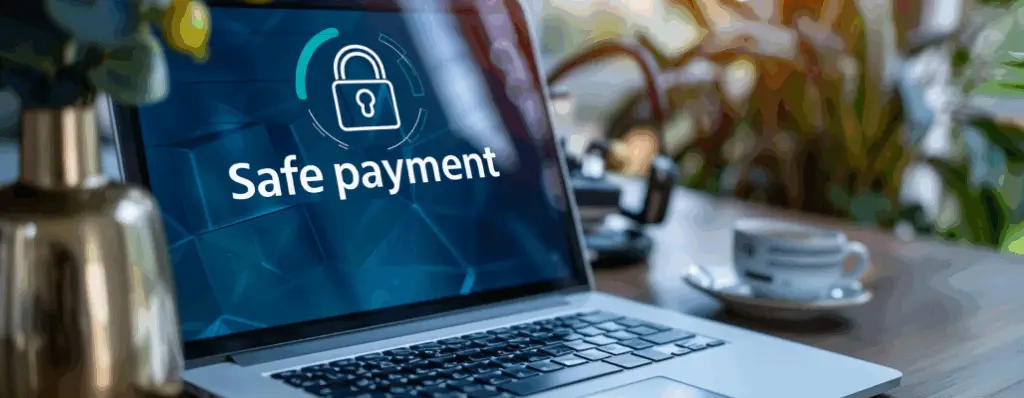Cybersecurity in Digital Payments: How to Stay Safe Online

In today’s digital age, the evolution of payment methods – from traditional card payments, contactless options to crypto currencies has revolutionised how consumers shop both online and in-store. However, this convenience brings an increased need for robust payment security to protect both businesses and customers from scams and fraud. This article explores essential practices for cybersecurity in digital payments offering valuable tips for businesses and consumers to navigate the complexities of payment security while fostering trust and seamless shopping experiences.
How safe are online payments?
Online payments make it easier for businesses to get paid and for shoppers to complete transactions. When the right security measures are in place, transactions are generally safe. However, as scams become more sophisticated, it’s essential to be aware of risks such as fraud, data theft, and other threats when making any type of payment online.
Choosing secure payment methods from authorized providers is the best way to have peace of mind. Credit cards and trusted mobile payment apps offer layers of protection for consumers, including encryption and two-factor authentication. Secure payment platforms make it even safer with extra safeguards such as 3D Secure, real-time fraud monitoring, and PCI DSS compliance.
Which payment methods are the safest?
Whichever online payment methods are offered by e-commerce merchants, the most important thing is that all methods are secure and backed by authorised providers.
- Visa and Mastercard credit cards are generally safe, thanks to protections like chargeback options, fraud detection and 3D secure for added authentication.
- Instant EFT payments are secure but irreversible, which means that customers need to carefully double-check recipient details before confirming payment. Only trusted platforms that encrypt data should be used to minimise risks.
- Mobile payment apps offer secure transactions through QR code scanning, while other mobile wallets, apps and contactless payments such as Scan to Pay, Apple Pay and Samsung Pay offer encryption and other security features. Apps should always be downloaded from official stores and unknown QR codes should never be scanned.
While each of these methods has safeguards in place, using a comprehensive payment platform can add additional layers of security, while making transactions faster and easier. Features like encryption, fraud monitoring and user verification help reduce risks for both businesses and consumers, providing a safer environment for online transactions. Along with improving security, a single payment platform that allows consumers to choose their preferred payment option helps to boost conversion through added convenience and increased trust signals, too.
Secure payment tips for businesses
One of the simplest ways to ensure secure payments for businesses is investing in a comprehensive payment platform that provides a full range of security features such as encryption and fraud detection, to prevent data breaches.
Businesses need to:
- Prioritise security to protect customer information and maintain trust, while also preventing potential threats that result in lost revenue. Relying on single or limited payment options can put businesses at risk especially if there is room for possible exploitation such as fake sales.
- Along with investing in a payment platform, it is essential to monitor transactions regularly. A platform that offers automated monitoring will help to detect any unusual activity so that potential threats can be noticed quickly.
- Employees and anyone managing the site should also be educated on current scams and threats to understand data handling protocols.
Bonus Tip: Investing in a secure and safe payment gateway reduces risk and helps build customer confidence, which is vital for business success.
Secure transaction tips for consumers
Cyber fraud, scams, data theft and other risks mean that consumers need to be extremely careful when conducting any type of transaction online. All it takes to put consumers at risk is one click on a fake link to a promotion that redirects to a phishing site. Although many consumers are growing increasingly aware of threats, cybercriminals are getting smarter and finding new ways to scam shoppers. Some of the ways that consumers can stay safe when making transactions online include the following:
- Reputable, trusted payment methods are essential when doing any type of transaction. Whether paying by credit card or a payment app, consumers should always ensure that selected methods have proven security features and SSL certificates.
- Two-factor authentication (2FA) should be activated on banking apps, Instant EFT, Apple accounts, Samsung accounts, and any other payment method that requires an added layer of security.
- Review Bank Statements regularly to look out for any suspicious transactions or unauthorised purchases.
- Payments should always be made on protected WiFi networks to ensure that they are fully secure.
Top Digital Payment Scams and How to Avoid Them
There are several digital payments scams you should look out for as an online shopper or a business running an online store that can lead to significant financial losses for both parties.
For Businesses:
- Friendly Fraud aka Chargeback Fraud. In this scam, customers make legitimate purchases but later dispute the charges to obtain refunds. Platforms that track transaction histories and provide detailed records can help businesses defend against chargebacks.
- Invoice Scams. Fraudsters pose as suppliers in these scams, sending false invoices to trick businesses into paying for non-existent goods or services. This type of scam can be prevented by verifying any changes in payment details directly with suppliers.
- Account Takeover Fraud. A more advanced fraud, this scam involves hackers gaining access to business accounts to perform unauthorised transactions. Using platforms with strong login protocols such as two-factor authentication helps prevent account takeovers.
- Triangulation Fraud. In this scam, a fake or replica website is created to entice buyers with cheap goods. These fake websites may appear in ads or be sent via email directing consumers to the website through a phishing attempt. Goods are not shipped as they don’t exist, leaving customers thinking that they have been conned by the real store. This can be hugely damaging to reputation, which has a direct effect on sales. It also affects consumers, who have given sensitive details to scammers (who then use this for further scams). Making it clear that your site uses trusted payment platforms and doing regular social media posts warning customers about this scam is essential to educate customers on how to check that they are shopping on a legitimate site.
For Consumers:
Consumers face numerous risks when transacting online. Some scams are very basic and easy to spot a mile away. Seeing a social media page or email that claims that a well-known brand is giving away huge prizes should be a red flag. Emails that you haven’t subscribed to can often be easily spotted as scams if there are obvious things like typos, or strange ‘reply-to’ fields that don’t seem to be from the store. In some cases, scammers target internet users who may not be tech-savvy, as they are seen as easy targets.
But many other scams are not as easy to spot, such as the following:
- Card-Not-Present Fraud. Also known as CNP fraud, this occurs when stolen card details are used for online purchases. To protect against CNP fraud, consumers should enable transaction alerts and use secure payment platforms.
- SIM Swap Scams. SIM swaps enable scammers to transfer your phone number to their own SIM card, as a way to get SMS-based two-factor authentication codes. Using app-based authentication rather than SMS and enabling extra security with mobile networks can reduce this risk.
- Store Account Takeovers. Stolen credentials can be used to access online store accounts, often making unauthorised purchases. To prevent this, consumers should always use unique passwords and enable two-factor authentication on store accounts.
- Fake E-Commerce Sites. These sites usually appear legitimate but exist only to steal payment information. Always verify site security by checking for HTTPS and an SSL Certificate and looking up reviews before entering payment details. Links from emails you haven’t subscribed to receive should never be clicked. Consumers should be wary of promotions, too – especially those that seem too good to be true.
- SMS Phishing Scams. Another common scam involves fraudsters impersonating organisations and targeting unsuspecting individuals with an SMS containing a link to an untrustworthy site to capture their information. For example, the SMS may say you’ve won a prize and to click the link to claim it. It’s important to check whether the URL has a legitimate domain, and if the message seems too good to be true then it most likely is.
Network makes digital payments safer & simpler

With online payments playing a larger role in daily transactions, securing digital payments is vital to ensure peace of mind, whether you own a store or shop at a store. This means understanding the potential risks of payment methods and knowing how payment platforms help to avoid scams, fraud, unauthorised transactions, data breaches, and other problems.
At Network, our goal is to equip businesses operating in the competitive e-commerce space with the tools needed to succeed. Providing customers with a smooth experience from start to finish isn’t just about having an easy checkout and a well-designed store. It’s also about making safety your number one priority. Offering a wide range of security features and hassle-free integration, our payment platform allows you to focus on your business while we handle your payment processing.
As a comprehensive secure online payment platform, Network provides businesses with all the tools needed for full peace of mind.
Some of the ways that we help make digital payments safer and simpler include the following:
- Easy Integration. Network integrates with over 50 different popular shopping cart platforms, including WooCommerce, Shopify and Magento, as well as custom website integrations.
- Flexible Payment Methods. Accepted trusted payment methods include Visa, Mastercard, Amex, Mpesa, Airtel, Scan to Pay, Samsung Pay, Apple Pay and more.
- Secure Payment Pages. When purchases are made on your site, customers are redirected to Network’s secure payment page, where they can choose their preferred payment method. Payments are then processed, your store is notified, and the checkout process can be completed.
- Enhanced Authentication with 3D Secure. This feature adds an extra layer of verification for credit card transactions, requiring users to authenticate their identity and reducing any unauthorised use.
- SSL Encryption. All data is secured with SSL encryption, ensuring that payment details and other sensitive information are fully protected from interception.
- Comprehensive Fraud Detection. Real-time monitoring helps to detect and prevent potential fraud, providing a secure payment environment.
- PCI DSS v4.0.1 Certification: Lastly, Network achieved and received the annual re-certification with PCI DSS v4.0.1 in 2025 which applies to all markets that we operate in.
FAQs
- Technology
- Financial Services
- Manufacturing
- Government
- Business Services
- Keep all software, plugins, and themes updated
- Enable Multi-Factor Authentication (MFA) for admin access
- Use SSL/TLS encryption for all transactions
- Choose hosting with Web Application Firewalls (WAF) and DDoS protection
- Display trusted payment logos and ensure your site uses HTTPS
Multi-Factor Authentication adds an extra layer of security beyond passwords. Even if credentials are stolen, MFA helps prevent unauthorized access to your admin dashboard.
Use a PCI DSS Level 1 compliant payment gateway. This ensures payment data is encrypted, reduces your compliance burden, and minimizes risk by avoiding storage of sensitive cardholder details.
- Apply security patches regularly
- Update store software and integrations
- Run monthly vulnerability scans
- Train staff on cybersecurity best practices
A vulnerability scan checks for weaknesses that hackers could exploit. Running scans monthly helps you catch issues early and maintain strong security.
Cyber threats evolve constantly. Staying secure means continuous monitoring, applying fixes, updating systems, and training staff—it’s not a one-time task.
Tokenization replaces sensitive card data with unique tokens, reducing the risk of theft. Even if tokens are intercepted, they cannot be used to make payments.
We use advanced encryption and tokenization to protect sensitive data. Tokenization replaces actual card details with unique tokens, so even if intercepted, the information cannot be used for payments.




